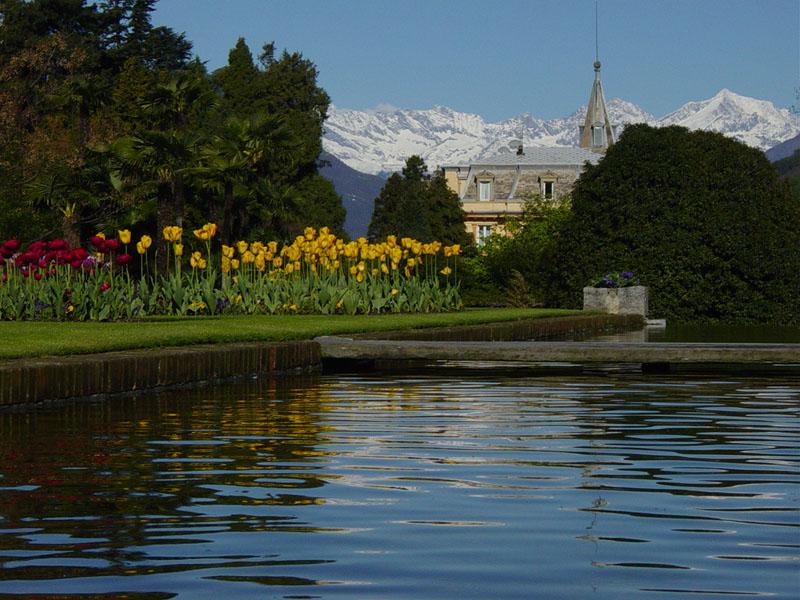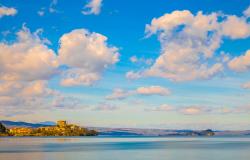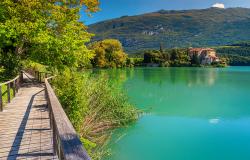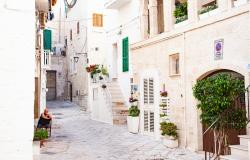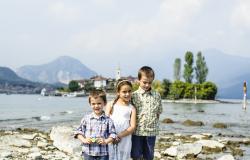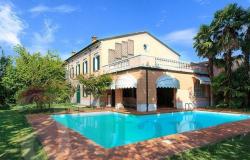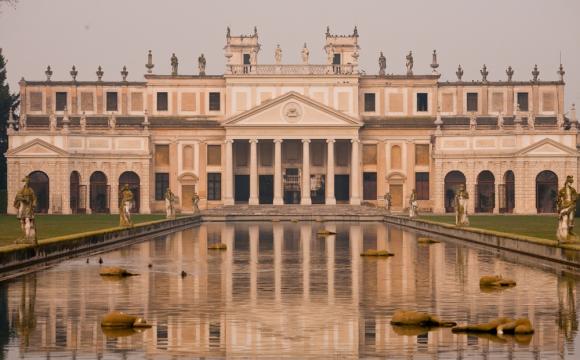Sculpture-ringed terrace thick with red, yellow and white flowers cascade down a hill to the shores of a sapphire lake. Topiary shrubs perfectly trimmed to look like verdant cakes stand proud above elegant parterres. And among the greenery a white peacock fans its train, candid against the deep blue of the waters.
Tall mountains and warm waters have gifted the Italian lakes with a mild microclimate and a lush vegetation, which in turn attracted gardening aficionados and designers from around the world.
Italian aristocrats, but also the beau monde from Scotland, England, Austria and Germany flocked here between the mid 19th century and the early part of the 20th century, building extraordinary villas and wrapping them in botanical marvels.
The end result is a collection of gardens in Italian or English style, crowded with peacocks, parrots and pheasants and thick with both Mediterranean shrubs and towering plants from as far afield as Africa and South America, which frame azure views of lake and sky.
It is difficult to choose which places to visit because they are all worth a trip—so much so that the area with the highest concentration of gardens, the western shore of Lake Maggiore, has been nicknamed ‘paradise on earth.’ If you are short on time, however, we have picked three gardens you really should not miss, and recommended a few more in the vicinity.
Best for variety: Villa Taranto, Pallanza, Lake Maggiore
 Villa Taranto was the brainchild of a Scottish garden enthusiast, Captain Neil McEacharn. Attracted by the lake’s rich soil and lovely climate, he bought the villa from the Marchioness of San’t Elia in 1931 and soon turned it into an English landscape paradise on Italian shores.
Villa Taranto was the brainchild of a Scottish garden enthusiast, Captain Neil McEacharn. Attracted by the lake’s rich soil and lovely climate, he bought the villa from the Marchioness of San’t Elia in 1931 and soon turned it into an English landscape paradise on Italian shores.
An expert botanist, he called in seeds and plants from every corner of the world, dug valleys and built terraces, placed fountains, waterfalls and lily ponds, and even created a miracle of plumbing to bring lake water to every corner of the estate. But the captain didn’t have the time to enjoy his jewel—the start of the Second World War in 1939 meant he had to leave Italy for Australia only eight years after having purchased the villa and before completing the gardens. He did come back after the war, though, and enjoyed his verdant masterpiece (which was completed in 1940) until his death in 1964.
Today, the gardens remain a Romantic paradise stretched between lake and mountains. A conifer-lined avenue brings into a lush heart planted with more than 20,000 species, some of which are extremely rare. There is the riot of reds, oranges and yellows that is the dahlia maze; the soft pinks, whites and purples of the man-made ‘valley;’ and the colourful order of the many terraces, where pink, yellow and red flowerbeds stand neatly among emerald grass parterres bordering azure ponds. But also the vivid, velvety pink of lotus flowers, the bright red leaves of a maple tree variety named after the Captain, and the gigantic leaves of the Victoria Cruziana waterlily, which can reach up to 2m in diametre.
Only the villa is off bounds—it is the seat of the local administration—but its graceful façade, standing ochre against the snow-capped mountains, provides an elegant architectural backdrop that makes the gardens even more attractive.
If you are on lake Maggiore, also visit: the lush English gardens on the Isola Madre and the Italian baroque ones at Isola Bella.
Best for views: Villa Melzi d’Eril, Bellagio, Lake Como
 Villa Melzi d’Eril stretches languidly along Lake Como, where the Bellagio peninsula parts the waters into two branches. It is a Neo-Classical masterpiece built in the early 19th century by architect Giocondo Albertolli for Francesco Melzi d’Eril, Duke of Lodi and Grand Chancellor of Napoleon’s reign in Italy.
Villa Melzi d’Eril stretches languidly along Lake Como, where the Bellagio peninsula parts the waters into two branches. It is a Neo-Classical masterpiece built in the early 19th century by architect Giocondo Albertolli for Francesco Melzi d’Eril, Duke of Lodi and Grand Chancellor of Napoleon’s reign in Italy.
Melzi wanted an elegant building, simple to the point of austerity, which would seamlessly blend with the watery surroundings. He then tasked architects Luigi Canonica and botanist Luigi Villoresi to create rolling English gardens dotted with sculptures and full of dramatic vistas to complete the landscape.
When entering the villa from Bellagio, though, the gardens’ first impression is more Asian than English. This is because a small Oriental garden was planted here in the second half of the 19th century, rich with Japanese maples and lily ponds.
Moving right towards the lake the atmosphere changes—a sculpture-studded Moorish gazebo sheltered by cypresses sets a different tone, preparing visitors for the majestic plane lined avenue that borders the lake.
The avenue, with the plane trees perfectly shaped into umbrellas, leads to the house, and the beautiful terrace that fronts it. This place alone makes the visit worthwhile, especially if you are more into vistas than into botany. Here, an elegant pond bordered by sculptures and dotted with white and pink waterlilies stretches towards the lake and the Alps beyond in an endless sequence of spectacular greens, whites and blues.
But turn behind the villa and again you enter another world—an intimate garden of rocks and flowers sloping gently uphill. Further on, past the museum housing Napoleonic relics, is the gardens’ most panoramic spot—what was once a tennis court is now a tree-shaded lawn overlooking the lake down to Tremezzo.
The views reign here but die-hard botanists can have their fill with rare or ancient plants, including Lebanon cedars and camphor trees. And no one should miss the intricate bamboo grove at the Loppia end of the gardens—it’s pure panda paradise.
If you are on lake Como, also visit: the Italian gardens of Villa Carlotta, in Tremezzo, and the panoramic terraces of Villa del Balbianello in Lenno.
Best for art: Andre Heller Garden, Gardone Riviera, Lake Garda
Austrian artist Andre Heller describes the lakeside town of Gardone Riviera as a place with two souls—the elegant lower town, a collection of waterside hotels, palazzos and bars that attracted Winston Churchill and fascinated Stefan Zweig; and the rural upper town, a maze of narrow alleys bordered by olive groves. Fastening the two together is his home and the lush botanical gardens that surround it.
The villa once belonged to Dr Arturo Hruska, dentist to the Italian kings, the last Russian tsar, king Albert of Belgium, and Popes Pius XII and John XXII. Hruska, who was as skilled with plants as he was with teeth, moved to Gardone Riviera to create his botanical garden, which he planted with the 3,000 or so species that he brought back from his many trips.
When he took over the property in the late 1980s, Heller built on Hruska’s work, enriching the glorious gardens and filling them with artwork.
Today, visiting the estate is like taking a tour around the world’s most fascinating species. There is the Alpine valley of pine trees, jagged rocks and waterfalls; the tropical scenery of a thick palm copse; and the Oriental flavour of koi and trout-peppered lily ponds, intricate bamboo groves and Zen waterworks.
In the words of Heller himself, it is a place of “edelweiss amidst orchid meadows; tree ferns several metres high next to pomegranate wonders; streams and waterfalls.” And resting gently among the verdant lawns are sculptures of Buddha and Ganesha alongside works by Keith Haring, Mimmo Paladino and Roy Lichtenstein, which both blend and contrast with nature’s own wonders.
The gardens may not be big but their variety and the way the artwork marries with the scenery and the flora more than makes up for their limited size, making this one of the best botanical gardens in Italy.
If you are on Lake Garda, also visit: the exotic gardens of Isola del Garda, and the whimsical ones of Il Vittoriale degli Italiani.
